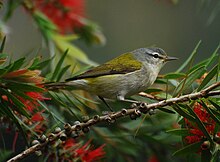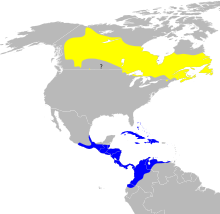Tennessee warbler
| Tennessee warbler | |
|---|---|
 |
|
| Scientific classification | |
| Kingdom: | Animalia |
| Phylum: | Chordata |
| Class: | Aves |
| Order: | Passeriformes |
| Family: | Parulidae |
| Genus: | Oreothlypis |
| Species: | O. peregrina |
| Binomial name | |
|
Oreothlypis peregrina (Wilson, 1811) |
|
 |
|
| Range of O. peregrina Breeding range Wintering range | |
| Synonyms | |
|
Helmintophila peregrina |
|
Helmintophila peregrina
Leiothlypis peregrina
Vermivora peregrina
The Tennessee warbler (Oreothlypis peregrina) is a New World warbler that breeds in eastern North America and winters in southern Central America and northern South America. The genus name Oreothlypis is from Ancient Greek oros, "mountain", and thlupis, an unidentified small bird; thlypis is often used in the scientific names of New World warblers. The specific peregrina is from Latin peregrinus "wanderer".
The Tennessee warbler is 11.5 cm (4.5 in) long, has a 19.69 cm (7.75 in) wingspan, and weighs roughly 10 g (0.35 oz). The breeding male has olive back, shoulders, rump and vent. The flight feathers are brownish-black. It has a slate gray neck, crown and eyeline. The underside is a gray-white. The female is similar to the male, but is much duller and has a greener tinge to the underside. The Tennessee warbler has long wings, short tail and a thin, pointy bill. Juveniles and first-year birds are quite similar to the female.
Tennessee warblers resemble female black-throated blue warblers. The only difference is that the black-throated blue has a darker cheek and two white wing spots.
This bird can be confused with the red-eyed vireo, which is larger, moves more deliberately and sings almost constantly. The orange-crowned warbler can also look similar, but lacks the white eyebrow, is greyer-brown above and has yellow undertail coverts.
It breeds from the Adirondack Mountains in New York through northern Vermont, New Hampshire, and Maine north and west throughout much of Canada. It is also found breeding in northeast Minnesota and northern Upper Peninsula of Michigan. It is migratory, wintering in southern Central America and northern Colombia and Venezuela, with a few stragglers going as far south as Ecuador. It is a very rare vagrant to western Europe. This bird was named from a specimen collected in Tennessee, where it may appear during migration.
...
Wikipedia

